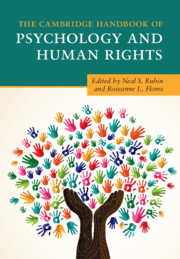Book contents
- The Cambridge Handbook of Psychology and Human Rights
- The Cambridge Handbook of Psychology and Human Rights
- Copyright page
- Dedication
- Contents
- Figures
- Tables
- Boxes
- Contributors
- Acknowledgments
- The Core International Human Rights Instruments and Their Monitoring Bodies
- Universal Human Rights Instruments
- Sustainable Development Goals
- Glossary of United Nations and Psychology Acronyms in the Handbook
- Introduction
- Part I History of Human Rights
- Part II The Intersection of Psychology and Human Rights
- 5 The Intersection of Psychology and Human Rights in Addressing Racism, Discrimination, and Xenophobia
- 6 Poverty and the Human Rights of Children and Youth through the Lenses of Psychology and Sociology
- 7 Labor Rights as Human Rights
- 8 Whose Culture? Challenging the Idea of an Opposition between Women’s Human Rights and the Right to Culture
- 9 Human Rights
- 10 Child Rights
- 11 Human Rights of Persons with Disabilities
- Part III Contemporary Issues in Psychology and Human Rights
- Part IV Teaching, Research, and Training in Psychology and Human Rights
- Part V Future Directions
- Index
- References
9 - Human Rights
A Psychologist’s Path to “Do No Harm”
from Part II - The Intersection of Psychology and Human Rights
Published online by Cambridge University Press: 02 October 2020
- The Cambridge Handbook of Psychology and Human Rights
- The Cambridge Handbook of Psychology and Human Rights
- Copyright page
- Dedication
- Contents
- Figures
- Tables
- Boxes
- Contributors
- Acknowledgments
- The Core International Human Rights Instruments and Their Monitoring Bodies
- Universal Human Rights Instruments
- Sustainable Development Goals
- Glossary of United Nations and Psychology Acronyms in the Handbook
- Introduction
- Part I History of Human Rights
- Part II The Intersection of Psychology and Human Rights
- 5 The Intersection of Psychology and Human Rights in Addressing Racism, Discrimination, and Xenophobia
- 6 Poverty and the Human Rights of Children and Youth through the Lenses of Psychology and Sociology
- 7 Labor Rights as Human Rights
- 8 Whose Culture? Challenging the Idea of an Opposition between Women’s Human Rights and the Right to Culture
- 9 Human Rights
- 10 Child Rights
- 11 Human Rights of Persons with Disabilities
- Part III Contemporary Issues in Psychology and Human Rights
- Part IV Teaching, Research, and Training in Psychology and Human Rights
- Part V Future Directions
- Index
- References
Summary
Embedded in psychological ethics is the principle of nonmaleficence – psychologists should endeavor to “do no harm.” Consistent with fundamental human rights, psychologists aim to protect integrity and dignity; secure development and fulfillment of lives; and ensure the well-being of individuals, groups, and communities. Psychological science and practice contains knowledge and insights that can be used to promote these aims. Unfortunately, this knowledge too often has been used to obstruct human integrity, destroy mental capacity and psychological health, and diminish the well-being and security of both persons and peoples. This chapter focuses on ways in which psychologists and psychological knowledge in different ways and at different levels may become part of an abusive culture that both violates human rights and fosters social injustice. In this chapter, we discuss psychologists’ involvement in torture and other cruel, inhuman, or degrading treatment across a range of settings. Through a case example, we highlight the interplay between direct and structural forms of violence and the path to harm created by ethical decision making devoid of human rights analyses. The need for a clear ethical and human rights–based approach in psychology is argued, including ways of dealing with violations and claiming accountability for crimes against humanity.
Keywords
- Type
- Chapter
- Information
- The Cambridge Handbook of Psychology and Human Rights , pp. 135 - 149Publisher: Cambridge University PressPrint publication year: 2020
References
- 1
- Cited by

